A sun-drenched garden is a beautiful sight, with its vibrant colors and lush greenery basking in the sun’s warmth. However, maintaining this type of garden can be challenging, as not all plants can thrive under such intense sunlight.
This is where full-sun perennials come in – these are flowering plants that can withstand the direct, unrelenting rays of the sun and still bloom abundantly year after year. Here we will take a closer look at full sun perennials and their benefits for your garden.
We have also curated a list of 28 full-sun perennials to add beauty and vibrancy to your outdoor space. From Asters to Yarrow, these plants offer a range of colors and textures. Additionally, we will provide tips on how to care for your sun-drenched garden so that it remains healthy year-round. We will also discuss full sun perennials for sun-drenched gardens.
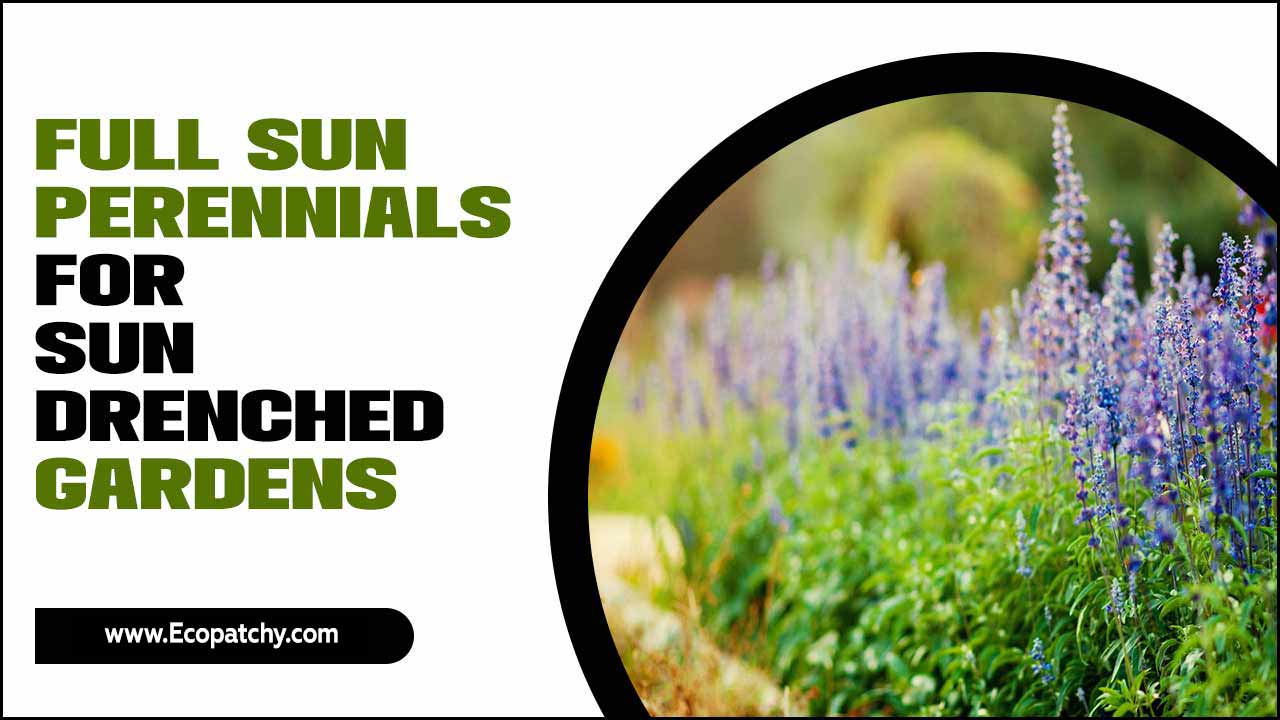
About Full Sun Perennials
Full sun perennials thrive in sunny locations with at least 6 hours of direct sunlight. They can withstand hot and dry conditions, making them perfect for warm climates. These plants offer vibrant colors and beautiful blooms, attracting pollinators like bees and butterflies. With a wide variety of sizes, shapes, and colors, full sun perennials can be a stunning addition to any garden. Whether you have a small container garden or a large plot of land, full sun perennials will thrive in your space.
Benefits Of Full Sun Perennials In Your Garden
Full sun perennials offer enduring beauty year after year, requiring minimal maintenance once established. These resilient plants can withstand various weather conditions, including heat and drought. Not only are they often resistant to pests and diseases, but full sun perennials also provide a constant source of color and interest in your garden.
With their ability to thrive in warm climates and tolerate the sun’s rays, they are ideal for creating stunning displays in sun-drenched gardens. Whether you have a small container garden or a vast expanse of land, full-sun perennials can add vibrant and showy flowers, silvery foliage, and seed heads that persist even in the early fall.
28 Full Sun Perennials For Sun-Drenched Gardens
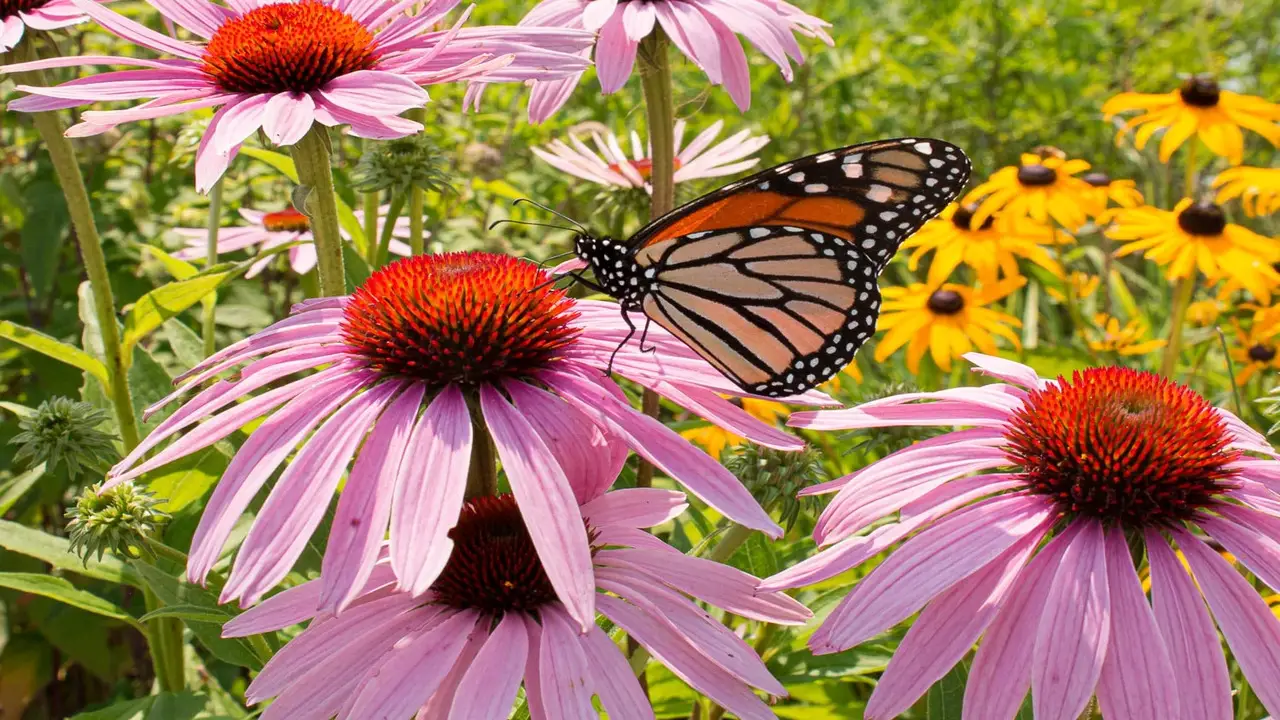
A burst of late-season color can be added to your garden with asters (asters spp), while Baby’s breath (gypsophila spp) produces delicate white flowers ideal for cut arrangements. Charming additions to any garden can be made with bell flowers (campanula spp), and balloon flowers (platycodon grandiflorus) have unique balloon-shaped buds that open into stunning blue flowers.
Black-eyed Susans (rudbeckia spp) feature bright yellow petals with a dark centre, attracting butterflies and bees. These perennial flowers are just a sample of the many options available for sun-drenched gardens.
1. Asters (Asters Spp)
Asters, versatile perennials with vibrant colors like blue, purple, and pink, thrive in full sun and well-drained soil. They bloom in late summer and fall, providing a burst of color when other plants have finished flowering. New England aster, smooth aster, and heath aster are popular varieties. Additionally, asters attract pollinators such as bees and butterflies to your garden. Incorporating asters into your landscape can add a stunning display of colors and bring life to your sun-drenched gardens.
2. Baby’s Breath (Gypsophila Spp)
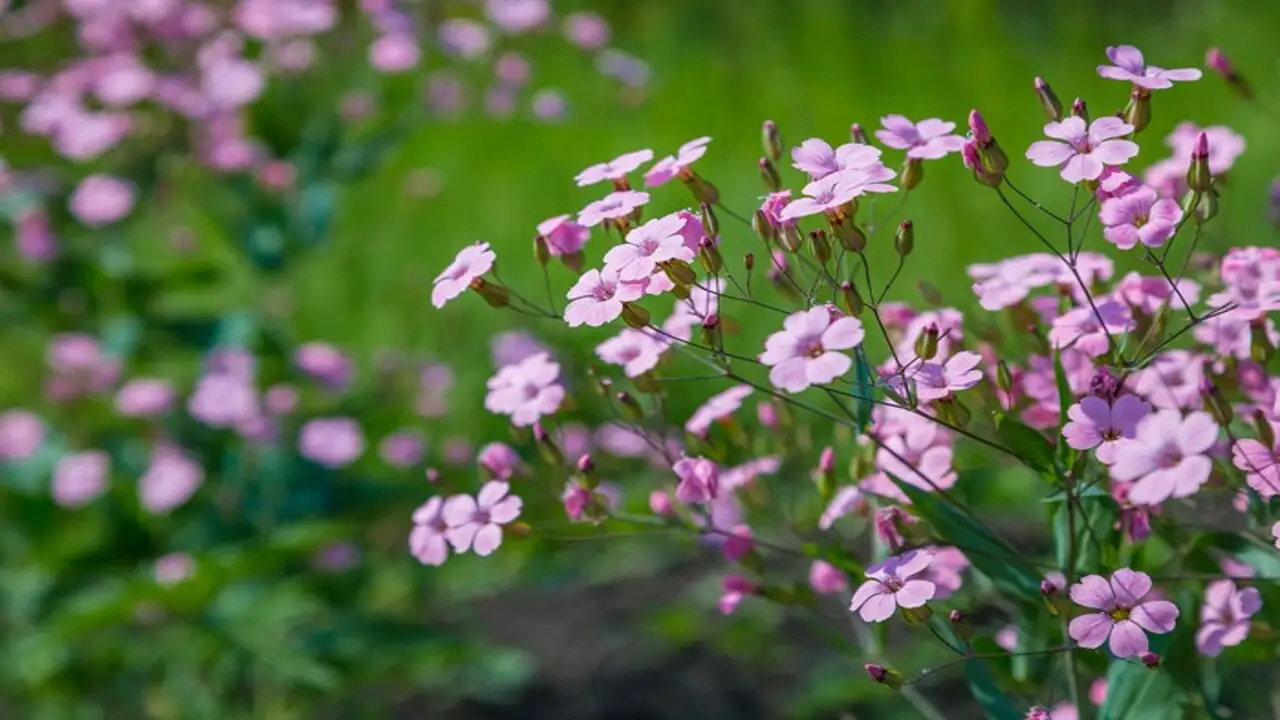
Baby’s Breath, or gypsophila spp, is a popular perennial with delicate white flowers. It thrives in full sun and well-drained soil, making it an excellent choice for sun-drenched gardens. This low-maintenance plant is often used as a filler in floral arrangements and can be grown as a cut flower.
Baby’s Breath attracts bees, butterflies, and other pollinators to your garden, adding to its beauty and biodiversity. Propagating this perennial can be done easily through division or seed. With its stunning blooms and ease of cultivation, Baby’s Breath is an ideal choice for any garden.
3. Bell Flowers (Campanula Spp)
Bell flowers, or campanula spp, are popular for gardens that receive a lot of sun. These perennial flowers come in various shapes and sizes, ranging from tall spikes to trailing vines. Their delicate, bell-shaped blooms in shades of blue, purple, pink, and white add beauty and charm to any garden. One of the advantages of bell flowers is their ability to thrive in different soil types, making them a versatile option for gardeners. Some well-known varieties of bell flowers include Campanula portenschlagiana, C. glomerata, and C. carpatica.
4. Baby’s Breath (Gypsophila Spp)
Baby’s Breath, or gypsophila spp, is a popular cut flower that thrives in full sun gardens. With delicate white or pink flowers that bloom in the summer, it adds a touch of elegance to any garden. One of the advantages of Baby’s Breath is its low-maintenance nature and ability to tolerate poor soil conditions. It’s a filler plant for borders, rock gardens, and meadow-style plantings. Whether you’re creating beautiful floral arrangements or looking to enhance your garden, Baby’s Breath is a versatile and stunning perennial option.
5. Balloon Flowers (Platycondon Grandiflorus)
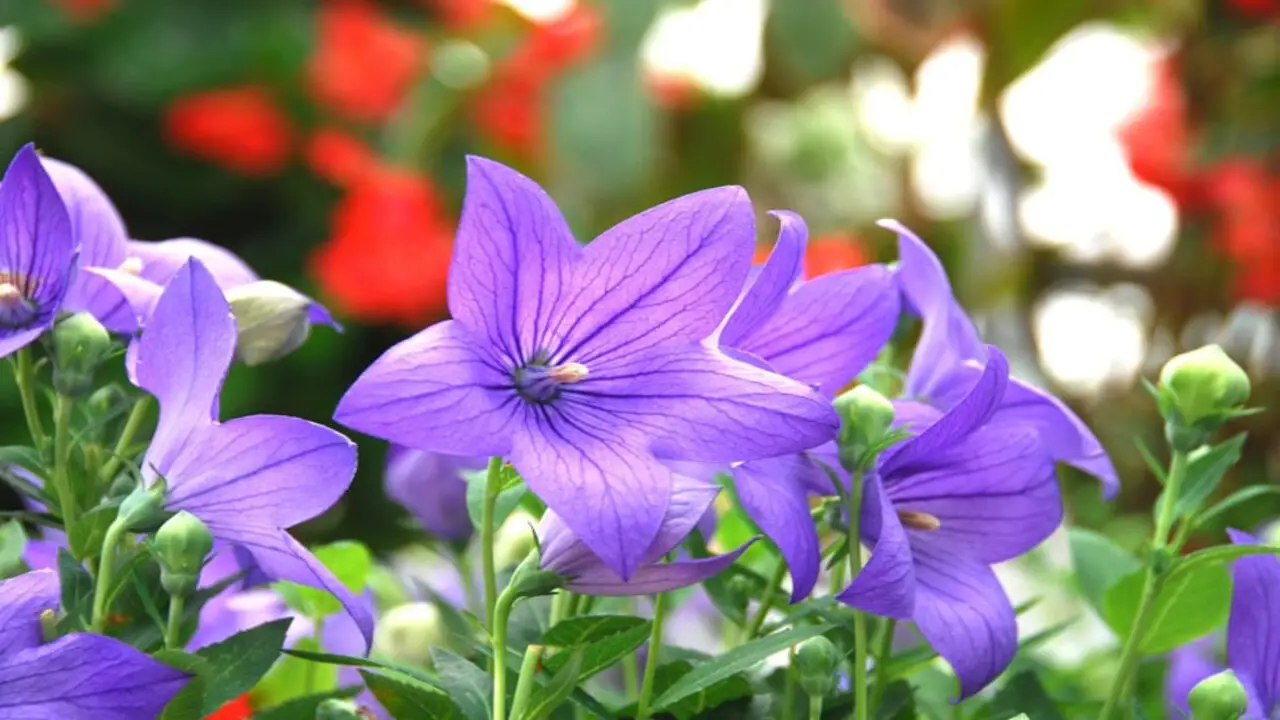
Balloon Flowers, or platycondon grandiflorus, are stunning full sun perennials that can thrive in gardens exposed to much sun. These beautiful flowers produce balloon-shaped buds that open into blue, pink, or white star-shaped blooms.
They are easy to grow and require less maintenance, making them a perfect choice for sun-drenched gardens. Balloon Flowers add a touch of elegance with their long-lasting and vibrant blooms. Whether you have a container garden or a large plot of land, these perennials will bring abundant summer color and add a charming ambiance to your outdoor space.
6. Bell Flowers (Campanula Spp)
Bellflowers, also known as campanula spp, are popular for sun-drenched gardens. With their vibrant colors ranging from blue and white to purple and pink, these perennial flowers add a touch of beauty to any landscape.
Easy to grow and maintain, bellflowers are perfect for beginners and can be planted in borders, rock gardens, or used as groundcover. While they prefer full sun, these versatile blooms can also tolerate partial shade. By deadheading spent blooms, you can encourage more flowers to bloom and attract pollinators like bees and butterflies to your garden.
7. Black-Eyed Susan (Rudbeckia)
Black-Eyed Susan, also known as rudbeckia, is a popular, easy-to-grow perennial that thrives in full sun. Its bright yellow or orange blooms with a dark center resemble a black eye, adding a vibrant touch to any garden. This flowering plant adds beauty and attracts pollinators like bees and butterflies.
With its ability to grow up to three feet tall and two feet wide, Black-Eyed Susan is an ideal choice for borders or mass plantings. It requires low maintenance and is drought tolerant, making it perfect for busy gardeners. Additionally, it can thrive in various soil types as long as it has good drainage.
8. Blanket Flower (Gaillardia)
Blanket flowers, or gaillardia, are vibrant and low-maintenance perennials that thrive in full sun. These daisy-like flowers come in shades of red, orange, and yellow, adding a pop of color to your garden. Not only do blanket flowers attract pollinators like bees and butterflies, but they are also drought-tolerant and can withstand heat and humidity. With bloom periods ranging from late spring to fall, these versatile perennials can be used in garden beds, borders, or as ground cover. Blanket flowers are great for adding long-lasting color to your sun-drenched garden.
9. Blazing Star (Liatris)
Blazing Star, known as Liatris, is a tall and eye-catching perennial that blooms in late summer. This stunning plant thrives in full sun and well-drained soil, making it a perfect choice for sun-drenched gardens. It produces spikes of purple or white flowers that add beauty to your garden and attract butterflies and bees.
Blazing Star is a low-maintenance and drought-tolerant plant once established, making it ideal for those who want a beautiful garden without much upkeep. Whether grown in garden borders, or meadows, or used as cut flowers for arrangements, Blazing Star is sure to impress. Additionally, this plant is deer and rabbit-resistant, ensuring that it remains undisturbed in your garden.
10.Chrysanthemums (Chrysanthemums Spp)

Chrysanthemums are popular for sunny gardens due to their vibrant colors and various sizes. They bloom during late summer and fall, adding color to your garden when other plants fade. These perennials are easy to care for and require minimal maintenance. Different types of chrysanthemums include cushion, pompon, and decorative varieties. They can be used as cut flowers, making them a great addition to bouquets or floral arrangements. For optimal growth, chrysanthemums prefer well-drained soil and full sun exposure.
11. Coneflower (Echinacea Purpurea)
Coneflower, also known as Echinacea purpurea, is an attractive perennial that thrives in full sun. With its pink or purple daisy-like flowers and cone-shaped center, it adds a vibrant touch to any garden. Besides its visual appeal, coneflowers are drought-tolerant and attract beneficial pollinators like bees and butterflies.
They bloom from mid-summer to fall, making them an excellent choice for adding color to your garden during this time. Additionally, coneflowers have medicinal properties and are commonly used in herbal remedies. Once established, they require minimal maintenance and grow well in well-drained soil.
12. Daylilies (Hemerocalis Spp.)
Daylilies, also known as hemerocalis spp., are a fantastic choice for sunny gardens. With their wide variety of colors and easy maintenance, they add beauty and vibrancy to any landscape. Blooming in mid to late summer, daylilies come in various sizes and shapes, making them a versatile addition to your garden.
Some popular varieties include ‘Stella de Oro,’ ‘Happy Returns,’ and ‘Pardon Me.’ These hardy perennials can thrive in various soil types, providing you with abundant blooms year after year. Whether planted in groups or mixed with other perennials, daylilies create a stunning display that will brighten your garden.
13. Delphiniums (Delphinium Spp.)
Delphiniums are tall perennials with stunning spikes of flowers in various shades of blue, pink, white, and purple. These beautiful plants thrive in full sun and well-drained soil but require regular watering during the growing season.
Delphiniums can be propagated through seeds or division, and cutting them back after flowering is recommended to encourage a second bloom. Popular varieties like ‘Galahad’ (white), ‘Pacific Giants’ (mixed colors), and ‘Black Knight’ (deep purple) are highly sought after for their vibrant blooms. Additionally, delphiniums attract pollinators like bees and butterflies, making them a perfect addition to any sunny landscape.
14. Flax, Perennial (Linum Sp.)
Flax, a hardy and low-maintenance perennial, thrives in full sun. Its delicate blue or white flowers bloom all summer, adding beauty to any garden. Flax prefers well-drained soil and can withstand drought, making it a resilient choice. Whether creating a cottage-style garden or looking for an accent in a mixed border, Flax is a great option. This versatile plant also offers the benefit of its fibers, which can be used to make linen fabric. Embrace the charm and practicality of Flax in your sun-drenched garden.
15.Hollyhock (Alcea Rosea)

Hollyhocks, or Alcea rosea, are tall and dramatic plants that add a stunning vertical element to any garden. Their range of vibrant colors, including pink, red, yellow, and white, bring a pop of beauty to any landscape. These perennial flowers thrive in full sun and require well-draining soil to flourish. Growing up to 6 feet tall, they are best planted at the back of a garden bed to create a captivating backdrop. Also, hollyhocks attract bees and butterflies with their showy flowers, making them a delightful addition to any sun-drenched garden.
16.Hyssop (Agastache Spp.)
Hyssop, a herbaceous perennial, thrives in full sun gardens with its spikes of tubular flowers in shades of pink, purple, and blue that bloom from mid-summer to fall. This plant attracts pollinators like bees, butterflies, and hummingbirds, adding life to your garden.
With its pleasant fragrance, hyssop serves culinary and medicinal purposes. Popular varieties include Agastache foeniculum, Agastache rupestris, and Agastache aurantiaca. Easy to grow and require minimal maintenance once established, hyssop is a great choice for full sun perennial flowers in sun-drenched gardens.
17. Lambs Ear (Stachys Sp.)
Lambs Ear, scientifically known as Stachys byzantina, is a perennial herb that thrives in full sun gardens. Its distinguishing feature is its soft and velvety leaves, which have a silver or grayish-green color. This plant can grow up to 18 inches tall and 24 inches wide, making it an ideal ground cover option. In early summer, Lambs Ear produces small pinkish-purple flowers on tall spikes. It requires minimal maintenance once established, as it is drought-tolerant and deer-resistant. Lambs Ear can be used in borders, rock gardens, containers, or as edging along walkways or paths.
18.Lavender (Lavandula Angustifolia)
Lavender, a popular full sun perennial, is renowned for its fragrant flowers and foliage. This easy-to-grow plant thrives in various soil types as long as they are well-draining. Lavender requires full sun exposure and is highly tolerant of heat and drought.
Regular pruning promotes bushier growth while preventing the development of woody stems. Not only is lavender commonly used for aromatherapy and cooking, it also serves as a versatile ingredient in crafts like making sachets or potpourri. With its delightful scent and multiple uses, lavender is a must-have addition to any sun-drenched garden.
19.Lupine (Lupinus Sp. )
Lupines, a genus of flowering plants in the Fabaceae family, are native to North and South America and the Mediterranean region. These stunning perennials are best known for their spiky and vibrant flowers in shades of blue, purple, pink, and white. With their preference for full sun and well-draining soil, lupines can thrive in various climates, from hot to cold. Not only do they add beauty to your garden, but they also attract pollinators like bees and butterflies. Incorporating lupines into your garden is a sure way to create a lively and vibrant space.
20. Phlox, Perennial (Phlox Spp)

Phlox is a popular variety of perennial flowers that thrive in full sun. With its vibrant colors ranging from pink, white, purple, and blue, to red, it adds a stunning display to any garden. This plant requires well-drained soil and regular watering, especially during dry periods. In the summer, Phlox blooms, attracting butterflies and hummingbirds to your garden. To encourage more blooms and extend the flowering season, it’s essential to deadhead spent flowers. Growing up to 3 feet tall, Phlox is ideal for planting at the back of a flower bed or against a fence.
21. Pinks (Dianthus Spp.)
Pinks are popular for sunny gardens, thanks to their vibrant colors and delightful fragrance. These easy-to-grow plants require minimal maintenance, making them perfect for beginner and experienced gardeners. With a wide range of varieties available, including annuals, biennials, and perennials, there is a pink to suit every garden style.
Cottage pinks, border pinks, and China pinks are some of the popular types. Pinks thrive in well-drained soil and full sun exposure, making them ideal for rock gardens, borders, or edging plants. Enjoy the beauty and charm of pinks in your sun-drenched garden.
22. Poppies (Papaver Orientale)
Poppies, known as papaver orientale, are popular for full-sun perennial flowers in sun-drenched gardens. Their bright and showy blooms come in shades of red, pink, orange, and white, adding a vibrant touch to any garden. These low-maintenance plants thrive in well-drained soil and require full sun exposure to reach their full potential. Deadheading spent blooms can encourage additional blooming, ensuring abundant and beautiful flowers throughout the season. However, it’s important to note that poppies can self-seed and spread, so occasional pruning or thinning may be necessary to maintain their desired appearance.
23. Red Hot Poker Plant (Kniphofia)
The red hot poker plant, also known as Kniphofia, is a stunning perennial with tall spikes of flowers in red, orange, and yellow shades. It thrives in full sun and well-draining soil, perfect for sun-drenched gardens. Not only does this plant add a pop of vibrant color to any landscape, but it also attracts hummingbirds and butterflies. The red hot poker plant can also be used as cut flowers in arrangements. It can bloom for several weeks during the summer season with proper care.
24. Russian Sage (Perovskia Atriplicifolia)
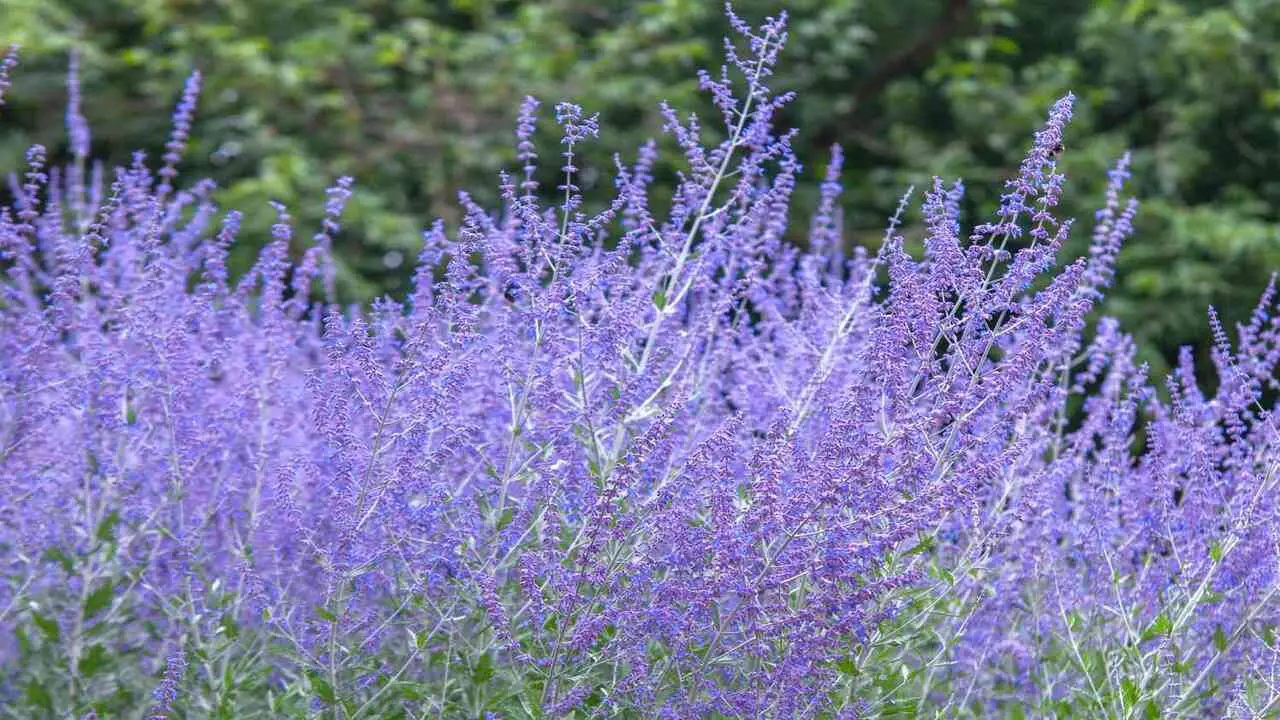
Russian Sage, also known as perovskia atriplicifolia, is a hardy perennial that thrives in full sun and well-drained soil. This drought-tolerant plant requires minimal maintenance, making it an excellent choice for busy gardeners.
With its silvery gray foliage and lavender-blue flowers, Russian Sage adds a touch of beauty to any garden. Not only is it visually appealing, but it also attracts pollinators such as bees, butterflies, and hummingbirds. Standing at a 3-5 feet height, it should be planted at least 2-3 feet apart from other plants to allow for proper growth. In colder climates, cutting back the plant in late winter or early spring helps stimulate new growth.
25. SAGE (Salvia Officinalis)
Sage, also known as Salvia officinalis, is a perennial herb that thrives in full sun and well-drained soil. With its savory flavor, it is commonly used in cooking to enhance the taste of various dishes. Besides its culinary uses, sage has medicinal properties, offering anti-inflammatory and antioxidant benefits. Additionally, this plant attracts beneficial insects like bees and butterflies to your garden, promoting a healthy ecosystem. Sage can be propagated through stem cuttings or by dividing existing plants, making it a versatile addition to any garden.
26. Stonecrop (Sedum)
Stonecrop, also known as Sedum, is a versatile perennial that thrives in full sun. With its low-maintenance nature, it’s a great addition to any garden. Stonecrop comes in various colors and shapes, from the upright Sedum spectabile to the ground-hugging Sedum acre. Its drought-tolerant nature allows it to grow in poor soil conditions, making it perfect for rock gardens or dry spots. Popular varieties such as ‘Autumn Joy,’ ‘Dragon’s Blood,’ and ‘Angelina’ offer a range of options. Additionally, Stonecrop attracts pollinators like bees and butterflies, adding life to your garden.
27. Tickseed (Coreopsis Spp.)
Tickseed, or coreopsis spp., is a popular choice for full sun perennial flowers. Its vibrant blooms in shades of yellow, pink, and red add a splash of color to any garden. One of the main advantages of tickseed is its low-maintenance nature, making it perfect for beginners or those with a busy schedule.
Additionally, this perennial attracts important pollinators like butterflies and bees, promoting a healthy and vibrant ecosystem. It’s also drought-tolerant, thriving in hot and dry conditions, which makes it an excellent option for sun-drenched gardens. Whether planted in rock gardens, borders, or containers, tickseed brings color and texture to your outdoor space.
28. Yarrow (Achillea Sp.)
Yarrow, also known as Achillea sp., is a versatile perennial that thrives in full sun and requires minimal care. With its clusters of small, brightly colored flowers in shades of pink, yellow, white, and red, yarrow adds a vibrant pop of color to any garden or landscape.
But its beauty isn’t the only reason to plant yarrow – it also attracts pollinators like bees and butterflies, making it a valuable addition to any ecosystem. Whether you want to propagate yarrow by division or seed, this hardy plant can thrive in various soil types. So why not add yarrow to your garden and enjoy its abundant blooms?
How To Care For Your Sun-Drenched Garden

Caring for a sun-drenched garden requires special attention to ensure your full sun perennials thrive. Following these care tips, you can enjoy a vibrant and thriving sun-drenched garden filled with beautiful full sun perennials. Here are some tips to help you care for your sun-drenched garden:
- Water Regularly: Full sun perennials can be more susceptible to drought, so watering them regularly, especially during hot summer, is important. Be sure to water deeply and avoid watering in the day’s heat to prevent evaporation.
- Mulch: Applying a layer of mulch around your plants can help retain moisture in the soil and reduce weed growth. Organic mulches like wood chips or straw are great options for sun-drenched gardens.
- Fertilize Appropriately: Full-sun perennials often require more nutrients due to their exposure to direct sunlight. Use a balanced fertilizer specifically formulated for flowering plants to provide the necessary nutrients for healthy growth.
- Prune And Deadhead: Regular pruning and deadheading can help promote new growth and prolong the blooming period of your full-sun perennials. Remove dead or damaged foliage and spent flowers to keep your garden tidy.
- Monitor Pests And Diseases: Sun-loving plants can attract certain pests and diseases. Look for common issues like aphids or powdery mildew, and take appropriate measures if you notice any signs of infestation or disease.
Conclusion
Incorporating full sun perennials into your garden has numerous benefits. They add vibrant colors, attract pollinators, and require less maintenance than annuals. With a wide variety of options like asters, bell flowers, black-eyed Susan, and lavender, you can create a stunning sun-drenched garden that blooms year after year.
To ensure the health and longevity of your plants, remember to provide them with adequate sunlight, water, and nutrients. Regular pruning, deadheading, and mulching will also help maintain their appearance. Following these care tips, you can enjoy a beautiful and thriving garden that brings joy and beauty to your outdoor space. We’ve discussed full sun perennials for sun-drenched gardens.
Frequently Asked Questions
1.What Plants Like Full Sun And Lots Of Water?
Ans: Some full sun plants that thrive with lots of water include dahlias, hibiscus, and cannas. Lavender, salvia, and yarrow are full sun plants that tolerate dry conditions. Adequate drainage is important to prevent root rot, and regular watering and fertilization keep these perennials healthy.
2.Which Perennials Thrive In Full Sun?
Ans: Perennials that thrive in full sun include Coneflower, Daylilies, and Sedum. Other options are Black-eyed Susan, Coreopsis, Lavender, Russian Sage, and Yarrow. These plants need at least six hours of direct sunlight daily and should be watered adequately during hot and dry periods.
3.What Plants Do Well In Hot Sunny Areas?
Ans: Some sun-loving perennials that thrive in hot, sunny areas include black-eyed susans, coneflowers, and daylilies. Lavender, salvia, and yarrow are great options for full sun gardens. Succulents like sedum and hens-and-chicks can also handle the heat and bright sun. Always check their specific light and water requirements when choosing plants for hot sunny areas.
4.What Perennials Bloom All Summer In The Sun?
Ans: Some perennials that bloom all summer in the sun include Coneflowers, Black-eyed Susans, and Daylilies. Other options are Salvia, Rudbeckia, and Coreopsis, which attract pollinators to your garden. Choose the right plant for your climate zone and soil type. Regular deadheading and fertilization extend the blooming periods of perennial plants.
5.What Kind Of Plant Is Best For The Front Porch?
Ans: For a vibrant front porch garden, consider full sun perennials like lavender, salvia, and yarrow. Choose compact plants like petunias or verbena for smaller porches. Opt for plants that bloom throughout the season to keep your front porch colorful. Research their sunlight and watering needs before planting.
